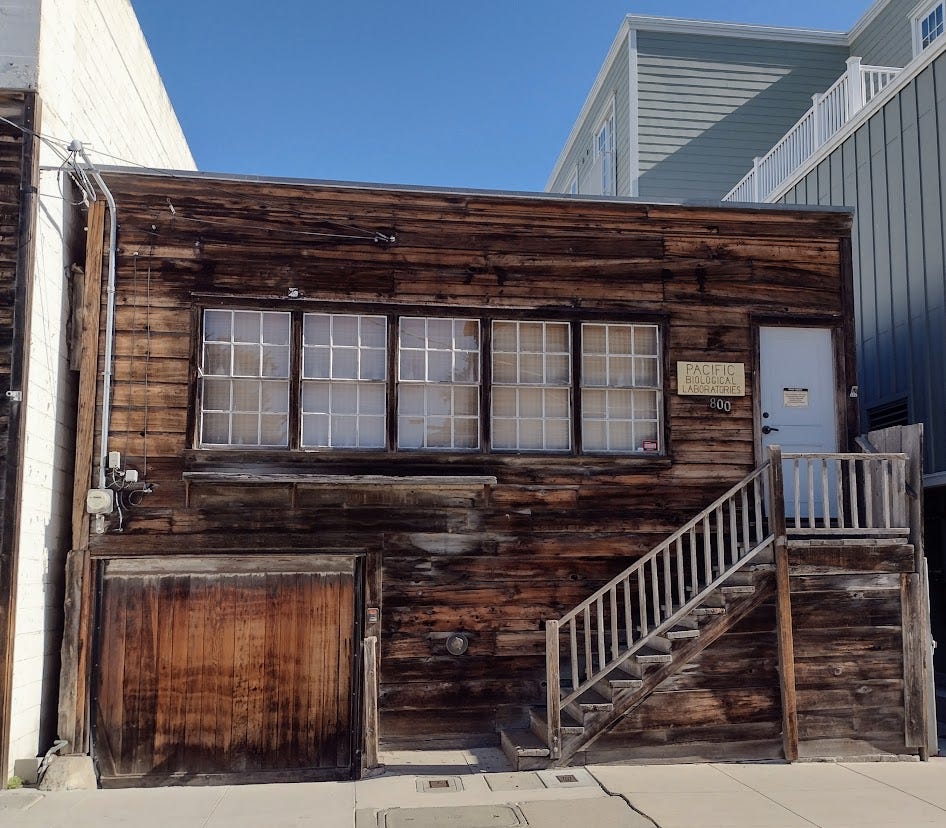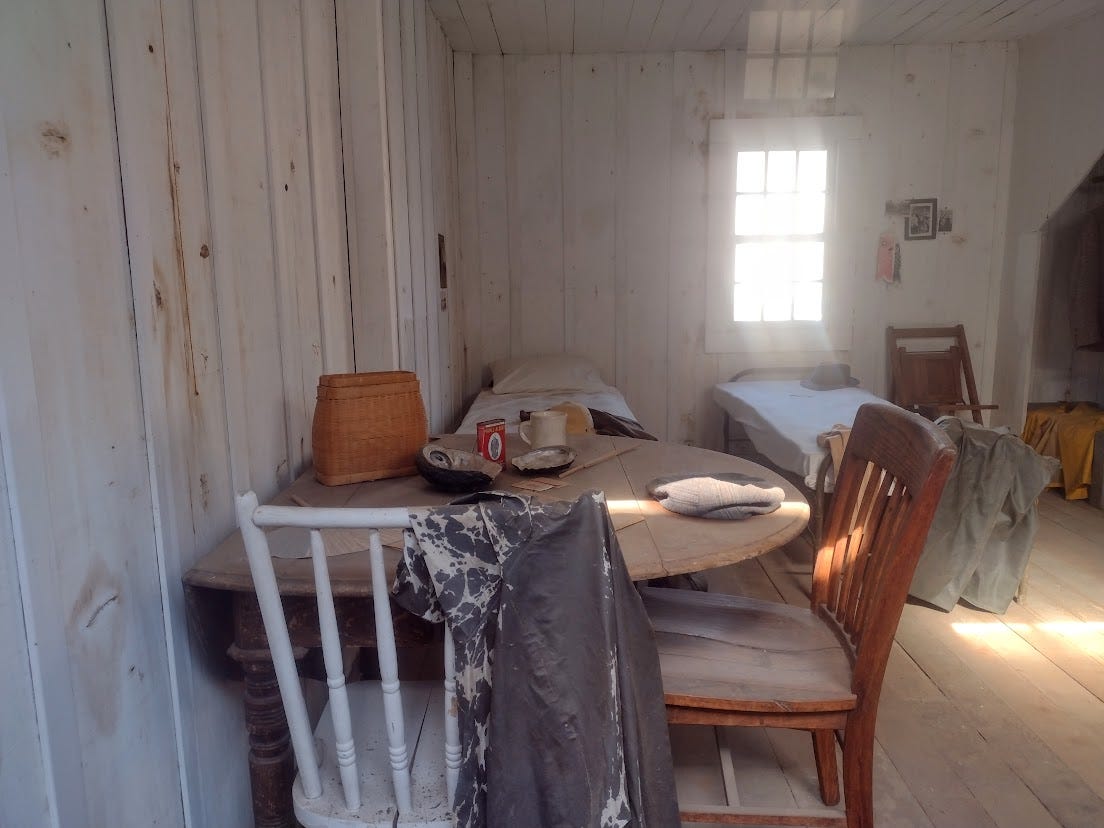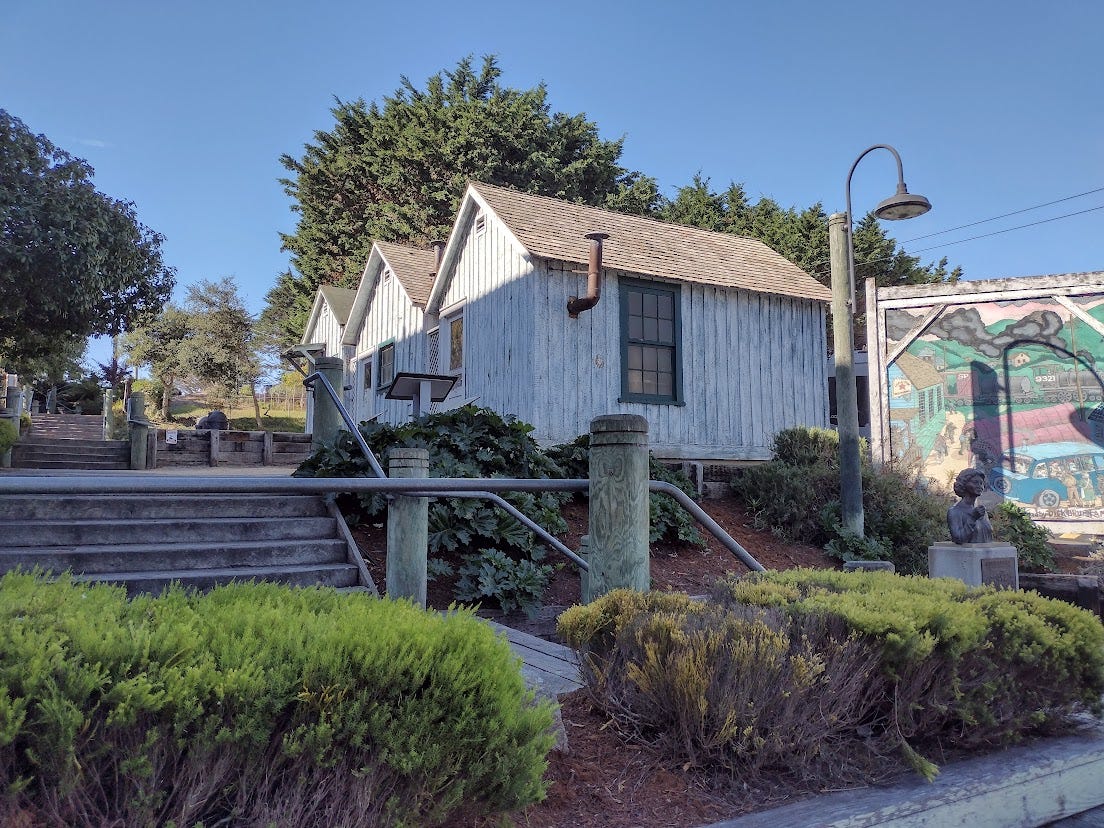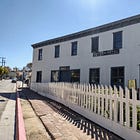
How Long Is This Post? About 1,800 words, or nine minutes
Dear Nonnie Friend,
It’s been quite the journey, not quite as planned, but then it never is. I said to someone the other day that Hoosen and I had been on the road for a month, and was astonished when Hoosen said, in his quiet but definite way, “No, it’s only been two weeks,” although he did allow that it was closer to two and a half weeks.
When away, I miss my books, I miss home comforts, but temptation of the road for me is, at least in part, this: When I stay home, even though I might have a varied schedule of work and rest, I still find the days zipping by. “Is it July already?” I say. Or October. Or January. Blimey.
Not so on a road trip. Every day is new, every place (even if we thought we knew it well) is new, everywhere, however unpromising, is made more interesting (and somehow connected to us) by digging even a little into how it became what it is now.
Tiring? Not if you do it right—which we don’t always—and make sure to spend a few days just vegging. But if all else fails, rest is what home is for.
See that photo above? That’s Monterey Bay, as seen from Cannery Row in Monterey, California. Hoosen and I sat on a park bench for quite some time, contemplating that view, watching cormorants (big birdies) roost nearby on the ruined remains of a fish cannery, and seals popping up in the surf.
If we were to Photoshop out some or all of the buildings on the distant far shore, then certainly, John Steinbeck would have recognized the scene. In his novel of the name in 1945, he immortalized Cannery Row, a place where a mostly immigrant workforce processed and packed sardines. Even while Steinbeck was there, the fish were fast vanishing, and when they finally disappeared, ten years later, the fishing and canning industries were decimated.
What happened to the sardines? Local marine biologist Edward Ricketts (the model for “Doc” in Steinbeck’s novel) crisply summed up the fate of the fishies in 1947: “They’re in cans.”
That’s relevant on the week when we learned in the news that helium, a non-renewable element needed for all sorts of important purposes, including MRI exams in hospitals, is now disappearing (even as loads of people cheerfully ignore warnings that mass balloon releases waste helium and endanger wildlife).
“Why didn't I learn X in school?” my American readers wail, and it sets my teeth on edge. How can we possibly learn everything? Certainly, there's not enough time for interesting and useful stories that inspire you to carry on learning throughout your life, not when the goal is for you to memorize laundry lists of “important” facts, especially Presidents. And that's been the goal for a long time. not of academic history (nobody asks us historians what we think, and especially not those of us who don’t do president stuff) but of politicians who meddle in curriculum. These days, with the avowed goal of “critical thinking” (🙄) and proclaiming “Rigor!” which is conflated with pain and suffering, most high school history curriculum is more dreary than ever. My teenage niece just shared her history essay assignment with me, and I almost lost the will to live just reading it, with its checklist approach. I told her this really wasn’t what history is about, and she looked at me doubtfully. I’m just a historian, after all. I do stories.
Stories! Guilty as charged. Know this: Despite appearances, I’m not going in search of “negative” stories about history when I travel. I’m not going in search of stories that tell me I’m right. I’m going in search of history, of stories that help me understand why places are the way they are today, and I do love to be surprised. I don’t plan for sad or disturbing stories (or my buddy FDR!) to keep popping up whenever I look beyond statues and other “positive” images. They just do.
This all starts with my historian’s curiosity, with not being interested in most statues (Here’s an important person you never heard of and we’re not telling you about, worship him!). I dislike tedious, badly-done museums (Here are some boring artifacts with minimal labels! You may now consider yourself educated!).
I refuse to be bored, and I take offense at paying to be bored. Enduring bad museum experiences as I travel is especially frustrating at a time when more and more people share my curiosity: You really do want to know what really happened in the past to communities, your own and others. That’s why you’re here, right?
(A thought: A friend in Los Angeles just asked if this trip is me preparing to write a book on museums. No, but maybe it should be? What do you think?)
We have to play detective to learn anything about the past by coming to Cannery Row today. There are still derelict-looking cannery buildings that haven’t been glitzified, but mostly Cannery Row looks like this, and has since the 1980s, when it evolved into a tourist attraction:

Steinbeck described Cannery Row in its heyday as “a poem, a stink, a grating noise, a quality of light, a tone, a habit, a nostalgia, a dream.” Well, Hoosen and I certainly heard a “grating noise” from the young people who so kindly shared their musical tastes with us from their passing motorbikes at 10,000 decibels. A “habit”? Maybe, a habit for us tourists to come to places like this for an experience that typically disappoints. A “nostalgia”? Sure. And I could go on. But a “dream”? Maybe. And maybe, compared to the Cannery Row Steinbeck describes, this tourist trap Cannery Row is more pleasant. At least we can enjoy the view, nibble some sugary treats, and have a sense of being somewhere else. Plus I love those old overhead walkways.
Thanks to the Interwebs, I learned that marine biologist “Doc” Ed Ricketts’ marine biology lab is still here. It’s right next to the acclaimed Monterey Bay Aquarium, which was renamed and magically transported to San Francisco in one of the Star Trek films to be home to two fictitious humpbacked whales named George and Gracie. I think it’s the one Spock was resurrected in. But I digress. Here's Ed Ricketts’s Lab:

There are no signs. Nobody gives it a second look. Why's Ricketts’s lab not labeled, I wonder, I said to the man next to me, who was also reading an info panel about Ricketts that didn’t mention the lab. My reading companion turned out to be a local. “Oh, it's still privately owned,” he said.
That's a very California, very Western answer. Forget the raging liberalism you've heard about: I've never seen so much beauty behind barbed wire or so many “Keep Out” signs as I have in the West.
Private Property In the West: Annette Wins The Essay Contest
When I was in high school in Sacramento, forty years ago, I entered a city-wide essay context staged by the local realtors’ organization. I was instructed to write about this: “Why private property rights are important to my future.” I was astonished: Why, I asked myself, would you tell teenagers what to think in the very question you ask? What’s the point? Where is the integrity? Isn’t this unAmerican, telling us what to think? Are you insane?
The realtors deserved what happened next. I rolled up my sleeves, pretended I was very, very conservative, and got tapping on my typewriter. Having read several books on American conservative politics (I was curious, Ronald Reagan having recently taken office), I knocked out an essay without too much trouble.
I won. The real estate agent who drove me to the awards ceremony confessed they had been afraid an adult might have written it (nope, just me, no plagiarism), and had had a high school teacher verify it was even possible for a student to write this well. Now she had met me and heard the accent, she understood. “Figures,” she shrugged. “A British education.”
“Oh, you bet your bippy, love,” I think to myself now. In those days, my no-frills state-funded school taught us to think and read for ourselves, regardless of politics. My dream, alas, wasn’t to become rich, so I spent the realtors’ $100 check taking two of my new American friends to a posh lunch in Sacramento in a gesture to selfless community. Oh, and Sacramento Board of Realtors? Bite me. Propaganda isn’t education. And I say exactly the same thing to everyone across the political spectrum who would make it so.
History Isn’t Old Buildings and Stuff
When we come to Cannery Row, and just look at old buildings, that’s not history. Buildings are silent artifacts. By themselves, they tell us nothing except, maybe, “Ooh, I’m old.” If we already have the education to know what they are, yay. But not even the most expert historian knows very much about the past. We all need explanation, or we might as well not bother.
That’s why I love info panels, sometimes called kiosks, those outdoor museum exhibits that bring history to us, without fuss. And it just so happens that the only site I came across in Monterey that was well supplied with info panels was a collection of remaining shacks that once housed cannery workers. Makes sense: Nobody would look at these just because they’re attractive, like fancy old mansions. They’re not. They’re sheds. We have to have them explained.

Men and women came from across the world for the filthy, poorly-paid work the sardine factories offered. Spanish, Filipinos, Japanese, Italians, and Portuguese were housed in basic cabins, and made them home. These cabins are locked, but I snapped photos of the displays inside through the window:

A good education teaches us to ask questions and be a detective, to at least have a hunch about where to go for answers. And a good museum, or historic house? Teaches a little but inspires a lot. My problem in Monterey was that I had to spend an awful lot of money and time to get even the most superficial introduction to the place. That’s because Monterey, while a tourist place in many ways, really isn’t aimed at tourists like me.
“How would you like to live in one of these cabins?” The posh mother called after her two running sons. They turned and laughed, but they barely paused on their way to the Monterey Bay Aquarium. Who could blame them? If I weren’t writing for you, I might have followed them. Wait until you hear how hard it was, exactly, to get interested in Monterey’s past.
And yet. Just thinking that California belonged once to Spain and then Mexico, that Monterey was another nation’s regional capital before it was a place for US industry, should make us think differently about the place, about the whole state, in the 21st century, about what we assume. California history isn’t well or widely known, and especially not this part of it, so learning anything is a win. I guess.
Don’t miss my second post from this visit to Monterey:
Update: Interested in the sardine situation in Monterey Bay more recently? I found this. Don't miss the collapse of sardine stocks (again) in recent years, amid political battles pitching commercial fishing against conservationists.
Got Your NBH Merch Yet?
And NBH depends on your word of mouth. Thank you for being (and telling!) a friend!






A Laing Historical museum directory sounds like a great idea ! You have shared information about some of the more interesting ones you and Hoosen have visited and I am willing to venture a guess that you have enough for an interesting book. And, just think, Annette, you could market it at one of these tourist spots with captive audiences. :)
So many former grimy industrial places have become trendy shopping and restaurant areas. I suppose the common denominator is that they generally employ workers on the lowest possible wage.